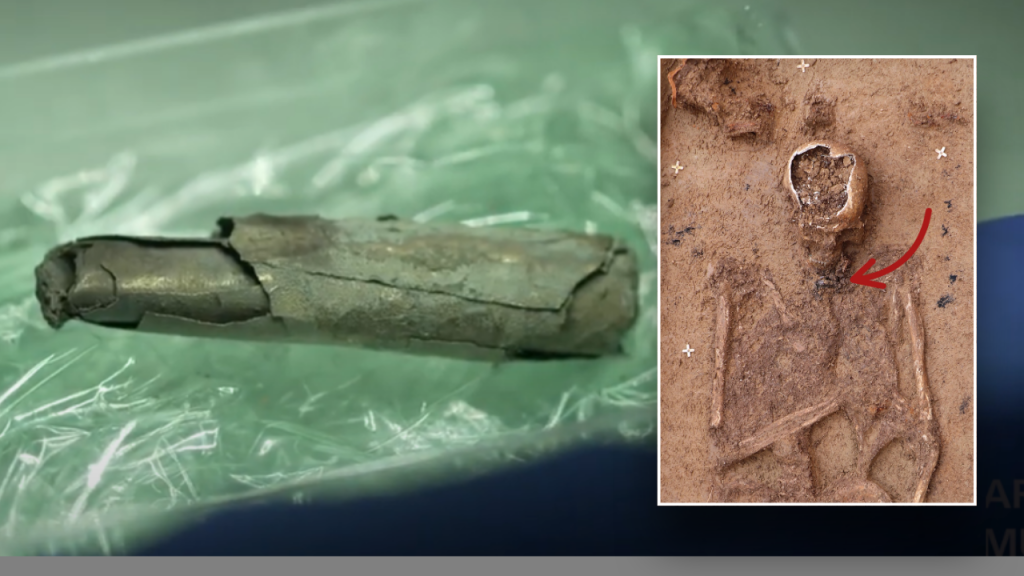The Frankfurt silver inscription, an extraordinary artifact unearthed in 2018 from a third-century Roman grave in Hesse, Germany, offers an unprecedented glimpse into the earliest days of Christianity north of the Alps. After years of meticulous analysis and painstaking decipherment, archaeologists unveiled this remarkable find to the public, hailing it as one of the “most important testimonies of early Christianity.” The inscription, etched onto a delicate silver foil and found wrapped within a small silver amulet, predates all other known evidence of Christianity in the region by at least half a century, pushing back the timeline of the religion’s spread northward.
The artifact’s significance lies not only in its age but also in its uniquely Christian character. The inscription, composed in Latin, an unusual choice for amulets of this period, invokes the name of Saint Titus, a first-century disciple of Paul the Apostle, and unequivocally proclaims the divinity of Jesus Christ. It entreats protection for the bearer in the name of Jesus Christ, “God’s Son,” and concludes with a powerful affirmation of Christ’s dominion over all creation: “The heavenly, the earthly and the underground, and every tongue confess (to Jesus Christ).” This unwavering focus on Christian doctrine, without any trace of Jewish or pagan influence, sets it apart from other similar amulets of the era, which often exhibited a syncretism of religious beliefs.
The process of deciphering the inscription proved to be a challenging endeavor. The silver foil, having been crumpled for nearly two millennia, required advanced technology and scholarly collaboration. Using computed tomography and other cutting-edge equipment, researchers were able to “digitally unroll” the delicate artifact, revealing the 18 lines of faded Latin text. The subsequent translation, led by Goethe University professor Markus Scholz, was a painstaking process, requiring expert consultation in theology and history and spanning weeks, sometimes months, to interpret each fragment of the inscription. Professor Scholz described the author as a “sophisticated” and “elaborate writer,” highlighting the intellectual depth behind the seemingly simple amulet.
The Frankfurt silver inscription challenges previous assumptions about the spread of Christianity in the Roman Empire. While historical accounts hinted at the presence of Christian communities in Gaul and possibly Upper Germania in the late second century, concrete evidence typically dates to the fourth century. This discovery provides tangible proof of Christian practice in the region significantly earlier than previously thought. It pushes back the established timeline by at least 50 years, suggesting a more rapid dissemination of the nascent religion across the Roman frontier than previously imagined. The inscription’s purely Christian nature further emphasizes its uniqueness, as contemporary amulets often incorporated elements of Judaism, paganism, or both, reflecting a more fluid religious landscape.
The artifact’s discovery in the former Roman city of Nida, located in present-day Hesse, Germany, offers valuable insights into the lives and beliefs of individuals living in this frontier region. It suggests the presence of a Christian community established enough to possess and cherish such a meticulously crafted object. The inscription, with its invocation of protection and its affirmation of Christian faith, likely served as a source of comfort and spiritual strength for its wearer, offering a tangible connection to a burgeoning religious movement that was rapidly transforming the Roman world. The amulet’s presence in a burial context further underscores the importance of Christian belief in the lives of these early adopters.
The Frankfurt silver inscription represents more than just an isolated artifact; it stands as a powerful testament to the early growth and spread of Christianity beyond the confines of Rome. It reveals a vibrant Christian community flourishing in what was then the northern reaches of the Roman Empire, challenging existing narratives about the timeline and character of early Christian expansion. This remarkable discovery will undoubtedly reshape our understanding of the religious landscape of the third century and provide valuable insights into the lives and beliefs of those who embraced this new faith. The inscription’s unambiguous affirmation of Christian doctrine, its sophisticated composition, and its remarkable preservation offer a unique window into a pivotal moment in the history of Christianity and the Roman world. It underscores the transformative power of faith and its enduring impact on the course of human history.

